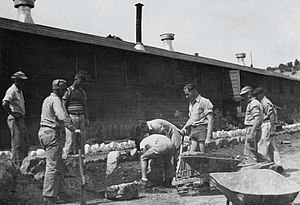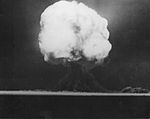
Fort Carson is a United States Army post located directly south of Colorado Springs in El Paso, Pueblo, Fremont, and Huerfano counties, Colorado, United States. The developed portion of Fort Carson is located near the City of Colorado Springs in El Paso County.
Marlag und Milag Nord was a Second World War German prisoner-of-war camp complex for men of the British and Canadian Merchant Navy and Royal Navy. It was located around the village of Westertimke, about 30 km (19 mi) north-east of Bremen, though in some sources the camp's location is given as Tarmstedt, a larger village about 4 km (2.5 mi) to the west. There were also American merchant seamen detained here as well as some U.S. Navy personnel.
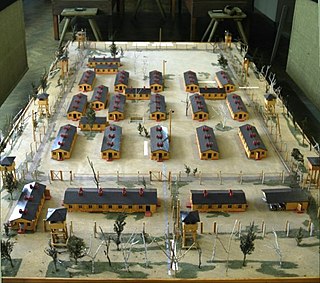
Stalag Luft III was a Luftwaffe-run prisoner-of-war (POW) camp during the Second World War, which held captured Western Allied air force personnel.

Stalag XX-A was a German World War II prisoner-of-war camp located in Toruń in German-occupied Poland. It was not a single camp and contained as many as 20,000 men at its peak. The main camp was located in seven forts of the 19th-century Toruń Fortress, located in the southern part of the city.

The Cowra breakout occurred on 5 August 1944, when 1,104 Japanese prisoners of war attempted to escape from a prisoner of war camp near Cowra, in New South Wales, Australia. It was the largest prison escape of World War II, as well as one of the bloodiest. During the escape and ensuing manhunt, four Australian soldiers and 231 Japanese soldiers were killed or committed suicide. The remaining escapees were re-captured and imprisoned.
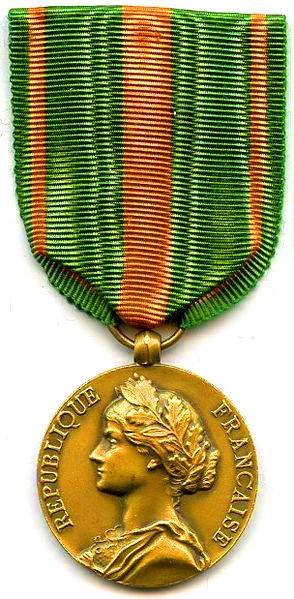
The Escapees' Medal is a military award bestowed by the government of France to individuals who were prisoners of war and who successfully escaped internment or died as a result of their escape attempt. The "Escapees' Medal" was established by a 1926 law, intended to honour combatants not only of the First World War, but also of the Franco-Prussian War of 1870. Its statute was later amended to include combatants of the Second World War and later conflicts.

The SS Columbus, was a German ocean liner laid down before the start of World War I. The vessel was originally to be named Hindenburg. However, her then-sister, originally named Columbus, was handed over to British government and then sold to the White Star Line after the war as part of reparations in 1920 and renamed Homeric by her new owners. The Allies allowed the Norddeutscher Lloyd (NDL), her owners, to keep the remaining ship. NDL decided to give her the name of her departed sister, now the British Homeric. Construction, which had been held up by the war, resumed at Schichau Shipyards in Danzig, Germany.
Fort Lincoln Internment Camp was a military post and internment camp located south of Bismarck, North Dakota, USA, on the east side of the Missouri River.

Fort Stanton was a United States Army fort near Lincoln, New Mexico.
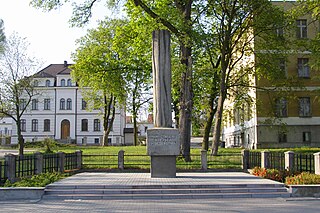
Oflag XXI-B and Stalag XXI-B were World War II German prisoner-of-war camps for officers and enlisted men, located at Szubin a few miles southwest of Bydgoszcz, Poland, which at that time was occupied by Nazi Germany.
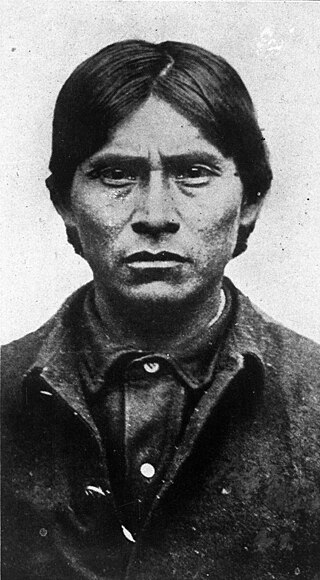
Haskay-bay-nay-ntayl, better known as the Apache Kid, was born in Aravaipa Canyon into one of the three local groups of the Aravaipa/Arivaipa Apache Band of San Carlos Apache, one subgroup of the Western Apache people. As a member of what the U.S. government called the "SI band", Kid developed important skills and became a famous and respected scout and later a notorious renegade active in the borderlands of the U.S. states of Arizona and New Mexico in the late 19th and possibly the early 20th centuries.

Stalag XXI-D was a German World War II prisoner-of-war camp based in Poznań in German-occupied Poland, operated in 1940–1945.

Camp Douglas was an internment camp for Prisoners of War (POW) during World War II, located in the city of Douglas, Wyoming, United States. Between January 1943 and February 1946 in the camp housing first Italian and then German prisoners of war in the United States. While there are few remaining structures, the walls of the Officer's Club were painted with murals by three Italian prisoners. These paintings depicting western life and folklore are now registered with the United States Department of the Interior National Park Service on the National Register of Historic Places. The story of this POW camp is an important part of the history of the town of Douglas.

The Battleground Gunfight, also known as the Battleground Shootout, was a gunfight between a posse of American lawmen and the Smith Gang. It was fought on October 8, 1901, within Arizona Territory's Fort Apache Indian Reservation, at a clearing in the forest known today as the "Battleground". Nine Arizona Rangers and deputies caught up with the cattle rustler Bill Smith and his gang. During a long exchange of gunfire that followed, Ranger Carlos Tafolla and Deputy Bill Maxwell were killed and one or two of the outlaws may have been wounded. In the end, the Smith Gang escaped the posse and fled into Mexico.
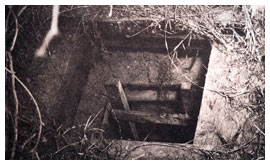
The Great Papago Escape was the largest Axis prisoner-of-war escape to occur from an American facility during World War II. On the night of December 23, 1944, twenty-five Germans tunneled out of Camp Papago Park, near Phoenix, Arizona, and fled into the surrounding desert.
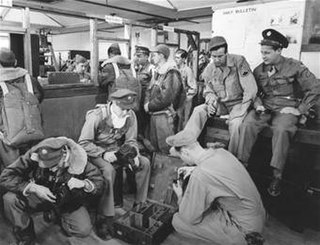
The history of New Mexico during World War II is characterized by dramatic and lasting changes to its economy, society, and politics. The state played a central role in the American war effort, contributing a disproportionately high number of servicemen and natural resources, and most famously serving as the location where the world's first nuclear weapon was designed, developed, and tested.

The Santa Fe riot was a confrontation at a Japanese internment camp near Santa Fe, New Mexico, during World War II. On March 12, 1945, approximately 275 internees assembled in Camp Santa Fe to watch and protest the removal of three men to another camp. During which, a scuffle broke out between the internees and the Border Patrol agents who were guarding the facility, resulting in the use of tear gas grenades, batons, and the serious injury of four internees.

The Lordsburg killings refers to the shooting of two elderly Japanese American men named Toshiro Kobata and Hirota Isomura at an internment camp outside Lordsburg, New Mexico, on July 27, 1942. The shooter, Private First Class Clarence Burleson, was charged with murder, but he was later acquitted after testifying that he was following military protocol.
Amherst Internment Camp was an internment camp that existed from 1914 to 1919 in Amherst, Nova Scotia. It was the largest internment camp in Canada during World War I; a maximum of 853 prisoners were housed at one time at the old Malleable Iron foundry on the corner of Hickman and Park Streets. The most famous prisoner at the camp was Leon Trotsky. There was a commemoration of the guards and prisoners for the 100th anniversary of the closing of the Amherst Internment Camp on July 2, 2019, at the Amherst Armoury.
